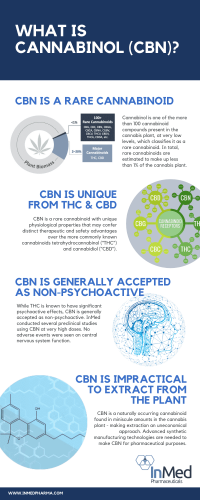Cannabinol (CBN) is a rare cannabinoid showing unique, potentially medically important properties for diseases with high unmet medical needs.

Cannabinol (CBN) is a rare cannabinoid found in very low levels in the plant
Cannabinol is one of the more than 100 cannabinoid compounds present in the Cannabis plant, albeit at very low levels, which classifies it as a rare or minor cannabinoid. In total, all rare cannabinoids are estimated to make up less than 1% of the Cannabis plant. CBN occurs naturally in cannabis as a degradant of tetrahydrocannabinol (THC). As the plant dries and THC is exposed to air, light and heat, CBN is produced in trace amounts. However, as opposed to THC, CBN is generally accepted as non-psychoactive.
Learn more about the science of CBN: Cannabinol 101: The Science of CBN
Cannabinol (CBN) is found in trace amounts in the Cannabis plant
As the Cannabis plant progresses through its life cycle, a wide variety of cannabinoid compounds are produced in different quantities at each stage. CBN is a rare or minor cannabinoid found in very small traces and is formed during the plant’s drying phase. CBN is produced from the degradation of THC following exposure to air, heat or light. Since CBN is found in such small quantities, it is not feasible to economically extract CBN directly from the plant for pharmaceutical use. Bio-identical versions of CBN can be produced synthetically via biosynthesis or chemical synthesis.

Cannabinol (CBN) is unique from tetrahydrocannabinol (THC), cannabidiol (CBD) and other cannabinoids
Each cannabinoid has a specific structure that confers unique physiological properties in humans. Evidence demonstrates that even a slight difference in the structure of these compounds can result in profound differences in biological activity, safety and potential therapeutic effect in the human body.
CBN is a rare or minor cannabinoid, found in trace amounts, that is produced from the degradation of THC. With a unique chemical structure different from other cannabinoids, such as THC and CBD, CBN has distinct affinity and specificity for receptors in the human body, including those in the endocannabinoid system, that result in different biological effects in humans. As opposed to THC, CBN is generally accepted as non-intoxicating. InMed is specifically exploring these unique effects of CBN, as well as other rare cannabinoids, and their therapeutic potential to treat disease.

What makes Cannabinol (CBN) a potentially well-suited cannabinoid for medical use?
Extensive preclinical and clinical testing undertaken by InMed have identified unique properties of CBN. CBN can act with higher potency when interacting with certain receptor systems in the body, while acting with lower potency for others when compared to other cannabinoids. CBN is also generally accepted as non-psychoactive. While both THC and CBD have established therapeutic benefits in certain instances, our data supports CBN having distinct advantages as potential treatments for epidermolysis bullosa and glaucoma, two diseases which are being studied by InMed and has completed Phase 2 clinical trials and in preclinical studies, respectively. A third program, INM-089, is a CBN analog drug candidate under development for age-related macular degeneration.
Due to its particular chemical structure, CBN is expected to maintain its structural integrity/stability under external stresses (e.g. heat, light) for a longer period of time. This unique feature of CBN may provide for longer shelf-life, which is an important commercial pharmaceutical parameter.
Read more about InMed’s INM-755 cannabinol topical cream: INM-755 Program for Epidermolysis Bullosa

Is Cannabinol (CBN) psychoactive?
While THC is known to have significant psychoactive effects, CBN is generally accepted as non-psychoactive. There has been limited direct research into the psychoactive effects of CBN in humans.
In its lead dermatology program for INM-755, InMed conducted several preclinical safety pharmacology and toxicology studies using CBN at very high doses that achieved systemic exposure (blood levels) hundreds of times higher than what would occur with topical dosing in humans. No adverse events were seen on central nervous system (CNS) function in a rigorous and extensive evaluation of CNS effects; 108 aspects of behavior posture, gait, and movement were assessed.
How does Cannabinol (CBN) work in the human body?
Cannabinoid receptors are found throughout the body and are involved in many different functions, such as pain perception, memory, immune function and sleep. Cannabinoids act as messengers that bind to cannabinoid receptors, as well as other receptors, signaling the endocannabinoid system into action. The relevance of the endocannabinoid system on many important physiological processes has made cannabinoids an important target to potentially treat a number of diseases and symptoms.
While there are numerous cannabinoid receptors in the human body, the two most well-known are the cannabinoid receptor 1 (CB1), which is more significant to the central nervous system, and cannabinoid receptor 2 (CB2), which is more common with the immune system. Scientific literature suggests that CBN has a greater effect on the immune system than on the central nervous system, however information on the effects of CBN on the endocannabinoid system are limited. InMed continues its research on the effects of CBN and how it interacts and modulates receptors in the body.

Is cannabinol (CBN) safe?
Until recently, there has been limited research on the safety of CBN. InMed is the leader in the research and development of CBN and has conducted several preclinical and clinical safety studies.
InMed’s Phase 1 and 2 clinical trials of INM-755 demonstrated that CBN is safe and well-tolerated. The Phase 2 trial indicated that INM-755 CBN cream was very well tolerated on sensitive EB skin. Results from two Phase 1 clinical studies of INM-755 cream in healthy volunteers treated for 14 days indicated that INM-755 cream was safe and well-tolerated on intact skin as well as open epidermal wounds, caused no systemic or serious adverse effects, and there were no subject withdrawals due to adverse events.
Previous to the Phase 1 and 2 clinical studies, InMed conducted several preclinical safety pharmacology and toxicology studies using CBN at doses that achieved systemic exposure (blood levels) hundreds of times higher than what would occur with topical dosing in humans. No adverse effects were observed even at the highest doses in preclinical studies where the drug was applied either as a cream (for local effects) or injected under the skin (for systemic effects) daily for 28 days.
While these data are very encouraging, more research is required to understand the full safety profile of CBN in humans.
Until significant, well-controlled clinical trials of CBN are conducted in humans, it is not appropriate for any amount of CBN to be used in humans of any age, for any purpose. While certain cannabinol may ultimately prove beneficial in treating disease, specific formulations, dosing regimens and delivery systems will need to be developed and thoroughly tested in clinical studies before it would be reasonable to contemplate therapeutic administration. It is much too early to speculate on what levels of CBN would be safe and effective.
Learn more about the role of cannabinoids in the treatment of glaucoma: Cannabis Treatments for Glaucoma
Cannabinol (CBN) cannot be extracted directly from plants for pharmaceutical use
CBN is a naturally occurring but rare cannabinoid produced by the Cannabis plant at very low levels. This very low concentration makes it impractical to obtain CBN cost-effectively through plant-based extraction processes. To produce sufficient amounts of CBN to meet potential pharmaceutical demand, alternative methods of manufacturing bio-identical CBN are being developed.
One key goal is to produce cannabinoids identical to those produced naturally in the plant. Biosynthesis or chemical synthesis of CBN may provide a reliable, consistent, scalable and compliant process compared to the variability and complexity associated with the extraction and purification of pure cannabinoids from the plant. In addition, we believe the costs associated with the large carbon footprint of greenhouses or exterior fields in combination with the security requirements, use of pesticides, fertilizers and variability in growth and expression of the target compound at a highly consistent level in the plant make the biosynthetic approach a more economically sound and socially responsible strategy from our perspective.
Currently, CBN is not available as an active pharmaceutical ingredient (API) in any approved drug product for any disease indication.









